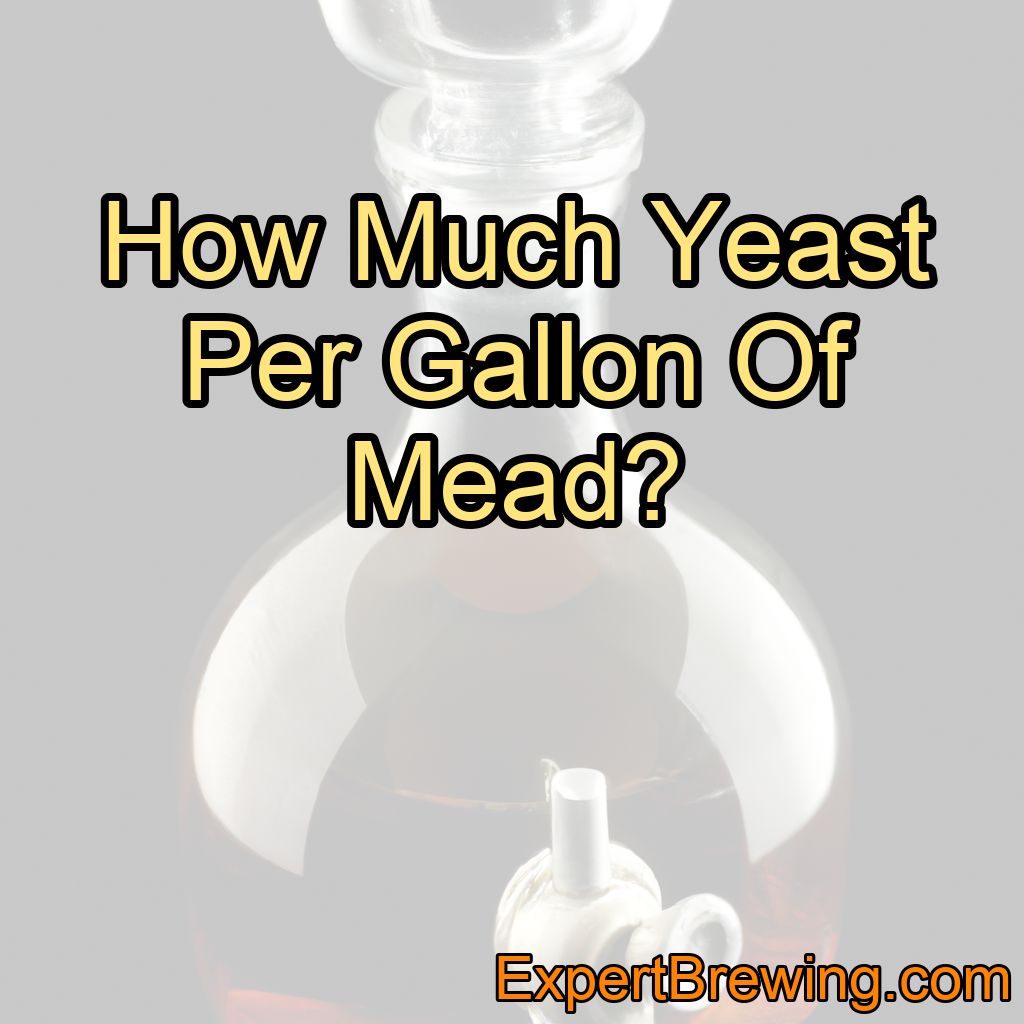Mead, the age-old honey wine, is gaining increasing popularity among homebrew enthusiasts. The process of brewing mead is relatively simple, but it requires a keen understanding of the ingredients involved, particularly the yeast.
The question I often get asked is, “how much yeast per gallon of mead?”. I use approximately 1 packet, or 5 grams, of yeast per gallon of mead.
However, the amount can vary depending on the specific yeast strain and the desired alcohol content of your mead.
In this article, we dive into the sweet world of mead and yeast, exploring everything from selecting the right yeast strain to understanding yeast nutrition and pitching rates.
Understanding Yeast’s Role in Mead Making
Yeast, a microorganism belonging to the fungi kingdom, is the unsung hero of the brewing process. As a brewer, yeast is your best ally.
Yeast consumes sugars, primarily fructose and glucose found in honey, and converts them into alcohol, carbon dioxide, and flavor compounds.
The yeast strain will influence the final flavor, aroma, and alcohol content of your mead.
Selecting the Right Yeast Strain
When it comes to brewing mead, not all yeast strains are created equal. The yeast strain you choose will largely depend on the type of mead you want to brew.
For example, if you’re aiming for a sweet mead, you might want to go for a yeast strain with a lower alcohol tolerance.
On the other hand, if you’re brewing a dry mead, a yeast strain with a higher alcohol tolerance would be more appropriate.
How Much Yeast Do You Need?
The answer to this question is dependent on a few factors, including the specific yeast strain and the desired alcohol content.

However, as a general rule of thumb, you’ll need approximately 1 packet, or 5 grams, of yeast per gallon of mead. This amount is typically sufficient to ensure a healthy fermentation process.
The truth is that, in theory, you don’t need that much yeast. In fact, one single yeast cell could be enough but often isn’t as chance of that cell dying is very high.
Therefore we often add much more than theoretically needed to be on the safe side (and to speed up the fermentation!).
Yeast Pitching Rates
The term ‘pitching rate’ refers to the amount of yeast added to the must (unfermented mead). It is usually measured in millions of cells per milliliter of must per degree Plato.
The pitching rate can drastically affect the fermentation speed, the formation of off-flavors, and the final alcohol content of the mead. The recommended pitching rate for mead is typically between 5-10 million cells/ml/°P.
Understanding Yeast Nutrition
Yeast nutrition is crucial for a healthy fermentation. Yeast requires nitrogen, phosphorus, potassium, and a slew of trace minerals to thrive.
Inadequate nutrition can lead to sluggish or stuck fermentation, off-flavors, and stressed yeast.
Nutrient Additions: A Step-by-Step Guide
When it comes to nutrient additions, timing is everything. The process typically involves adding nutrients in stages, often referred to as ‘staggered nutrient additions.’ This method ensures that the yeast has enough nutrients throughout the fermentation process.
Here is a step-by-step guide to nutrient additions in mead brewing:
- Understand Your Recipe: Before you begin the fermentation process, it’s essential to understand the specific nutrient requirements of your mead recipe. Different honey varieties and adjuncts may have varying nutrient profiles, so be sure to familiarize yourself with the ingredients you are using.
- Choose the Right Nutrient Mix: There are various nutrient mixes available in the market designed specifically for mead fermentation. These mixes usually contain a combination of key nutrients like nitrogen, vitamins, minerals, and amino acids. Opt for a high-quality nutrient mix to support a healthy and vigorous fermentation.
- Create a Nutrient Schedule: Planning your nutrient additions in advance is crucial for success. Mead fermentation is generally divided into three phases: the lag phase, exponential growth phase, and the stationary phase. For each phase, you’ll need to calculate the appropriate nutrient additions based on your batch size and the nutrient mix you’re using.
- Lag Phase Nutrient Addition: The lag phase occurs during the initial stage of fermentation when the yeast is acclimating to its new environment. You’ll want to add a portion of the nutrients during this phase to support yeast health and help prevent stress-related issues. Follow your nutrient mix instructions for the specific dosage.
- Exponential Growth Phase Nutrient Addition: As fermentation progresses and the yeast starts actively multiplying, they will require additional nutrients to sustain their growth. This is typically the most critical phase for nutrient additions. Split the recommended nutrient dosage into multiple additions and spread them over the exponential growth phase, ensuring the yeast always has access to the necessary nutrients.
- Stirring and Oxygenation: To aid nutrient absorption and promote yeast health, consider stirring the must gently during each nutrient addition. Additionally, providing controlled aeration can improve yeast health during the early stages of fermentation.
- Stationary Phase Nutrient Addition (Optional): Some mead makers opt to add a final nutrient dose near the end of fermentation, around the time when most of the sugar has been converted. This additional nutrient boost can help the yeast complete fermentation more efficiently.
- Avoid Overfeeding: While nutrients are essential for a successful fermentation, overfeeding the yeast can lead to off-flavors or other fermentation issues. Always follow the recommended nutrient schedule and dosage for your specific mead recipe.
- Keep Detailed Records: Throughout the fermentation process, maintain detailed records of the nutrient additions, fermentation temperatures, and any observations you make. This information will be invaluable for future batches and troubleshooting any problems that may arise.
Remember, nutrient additions are just one aspect of successful mead fermentation. Proper sanitation, temperature control, and using a suitable yeast strain are also crucial for achieving the desired flavor profile in your mead. With careful attention to detail and a well-planned nutrient regimen, you’ll be on your way to crafting delicious and well-balanced meads. Happy brewing!
Ensuring a Successful Fermentation
Ensuring a successful fermentation involves more than just pitching the right amount of yeast and providing adequate nutrition. Temperature control, aeration, and monitoring the fermentation progress are all crucial elements.
Troubleshooting Common Issues
Despite our best efforts, fermentation issues can still arise. Knowing how to identify and troubleshoot these common issues can save your mead from becoming a dud.
Conclusion
In conclusion, brewing mead is a fascinating process that requires a deep understanding of the role yeast plays. The amount of yeast needed per gallon of mead is approximately 5 grams, but this can vary depending on the specific yeast strain and the desired alcohol content. Understanding yeast nutrition and pitching rates, and being able to troubleshoot common fermentation issues, are all part of the brewer’s toolkit.
Here are some key takeaways from this article:
1. Yeast plays a crucial role in mead making, converting sugars into alcohol and flavor compounds.
2. The yeast strain you choose will influence the final product in terms of flavor, aroma, and alcohol content.
3. You’ll typically need about 5 grams of yeast per gallon of mead.
4. Pitching rates affect the fermentation speed, flavor, and alcohol content of your mead.
5. Yeast requires adequate nutrition to ensure a healthy fermentation.
6. Staggered nutrient additions can help maintain yeast health throughout the fermentation process.
7. Temperature control, aeration, and monitoring are crucial for successful fermentation.
8. Being able to troubleshoot common fermentation issues can save your mead from becoming a dud.
9. Approximately 1 packet of yeast per gallon of mead is recommended.
10. Understanding yeast is fundamental to brewing excellent mead.
Happy brewing!
FAQs
How much active dry yeast for 1 gallon of mead?
For 1 gallon of mead, you would typically use about 1/2 to 1 teaspoon of active dry yeast, depending on the desired fermentation speed and yeast strain being used.
How much yeast do I need for 1 gallon?
For 1 gallon of liquid, you typically need about 1/4 to 1/2 teaspoon of yeast. The exact amount may vary depending on the recipe and the desired fermentation time.
How much honey do I need to make 5 gallons of mead?
To make 5 gallons of mead, you typically need around 15-18 pounds of honey. The exact amount may vary depending on your desired sweetness and the specific recipe you are following.
What is the best yeast to use for mead?
The best yeast to use for mead is typically a wine yeast strain, such as Lalvin D-47 or Lalvin K1-V1116. These yeast strains are known for their ability to ferment mead to dryness, resulting in a clean and well-balanced finished product. They also have a high alcohol tolerance, which is important for mead production. Additionally, Lalvin D-47 and Lalvin K1-V1116 are known for enhancing the fruity and floral flavors in mead, making them popular choices among mead makers.
How many packs of yeast for 5 gallons of mead?
For a 5-gallon batch of mead, it is generally recommended to use one packet or about 5 grams of yeast. However, the specific yeast strain, desired fermentation characteristics, and recipe details may influence the amount of yeast required. It’s always best to consult the instructions provided by the yeast manufacturer or consult a brewing resource for more precise recommendations.
Can I use dry active yeast with a mead?
Yes, you can use dry active yeast with mead. Dry active yeast is commonly used in mead making as it provides a reliable fermentation process. It is important to rehydrate the yeast according to the manufacturer’s instructions before adding it to your mead must. This will ensure optimal yeast activity and a successful fermentation.






